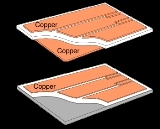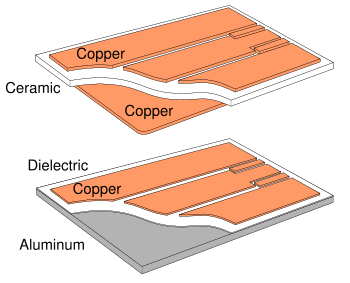
Power electronic substrate
Encyclopedia
The role of the substrate
in power electronics
is to provide the interconnections to form an electric circuit (like a printed circuit board
), and to cool the components. Compared to materials and techniques used in lower power microelectronics
, these substrates must carry higher currents and provide a higher voltage isolation (up to several thousand volts). They also must operate over a wide temperature range (up to 150 or 200°C).
 Direct bonded copper (DBC) substrates are commonly used in power module
Direct bonded copper (DBC) substrates are commonly used in power module
s, because of their very good thermal conductivity
. They are composed of a ceramic tile (commonly alumina) with a sheet of copper
bonded to one or both sides by a high-temperature oxidation process (the copper and substrate are heated to a carefully controlled temperature in an atmosphere of nitrogen containing about 30 ppm of oxygen; under these conditions, a copper-oxygen eutectic forms which bonds successfully both to copper and the oxides used as substrates). The top copper layer can be preformed prior to firing or chemically etched using printed circuit board
technology to form an electrical circuit, while the bottom copper layer is usually kept plain. The substrate is attached to a heat spreader
by soldering the bottom copper layer to it.
Ceramic material used in DBC include:
One of the main advantages of the DBC substrates is their low coefficient of thermal expansion, which is close to that of silicon
(compared to pure copper
). This ensures good thermal cycling performances (up to 50,000 cycles). The DBC substrates also have excellent electrical insulation and good heat spreading characteristics.
A related technique uses a seed layer, photoimaging, and then additional copper plating to allow for fine lines (as small as 50 micrometres) and through-vias to connect front and back sides. This can be combined with polymer-based circuits to create high density substrates that eliminate the need for direct connection of power devices to heat sinks.
is commonly used because of its low cost and density) covered by a thin layer of dielectric
(usually an epoxy-based layer) and a layer of copper (35 µm to more than 200 µm thick). The FR-4
-based dielectric is usually thin (about 100 μm) because it has poor thermal conductivity compared to the ceramics used in DBC substrates.
Due to its structure, the IMS is a single-sided substrate, i.e it can only accommodate components on the copper side. In most applications, the baseplate is attached to a heatsink to provide cooling, usually using thermal grease
and screws. Some IMS substrates are available with a copper baseplate for better thermal performances.
Compared to a classical printed circuit board, the IMS provides a better heat dissipation. It is one of the simplest way to provide efficient cooling to surface mount components.
Wafer (electronics)
A wafer is a thin slice of semiconductor material, such as a silicon crystal, used in the fabrication of integrated circuits and other microdevices...
in power electronics
Power electronics
Power electronics is the application of solid-state electronics for the control and conversion of electric power.-Introduction:Power electronic converters can be found wherever there is a need to modify a form of electrical energy...
is to provide the interconnections to form an electric circuit (like a printed circuit board
Printed circuit board
A printed circuit board, or PCB, is used to mechanically support and electrically connect electronic components using conductive pathways, tracks or signal traces etched from copper sheets laminated onto a non-conductive substrate. It is also referred to as printed wiring board or etched wiring...
), and to cool the components. Compared to materials and techniques used in lower power microelectronics
Microelectronics
Microelectronics is a subfield of electronics. As the name suggests, microelectronics relates to the study and manufacture of very small electronic components. Usually, but not always, this means micrometre-scale or smaller,. These devices are made from semiconductors...
, these substrates must carry higher currents and provide a higher voltage isolation (up to several thousand volts). They also must operate over a wide temperature range (up to 150 or 200°C).
Direct bonded copper substrate

Power module
A power electronic module provides the physical containment for several power components, usually Power semiconductor devices. This package provides an easy way to cool the devices and to connect them to the outer circuit....
s, because of their very good thermal conductivity
Thermal conductivity
In physics, thermal conductivity, k, is the property of a material's ability to conduct heat. It appears primarily in Fourier's Law for heat conduction....
. They are composed of a ceramic tile (commonly alumina) with a sheet of copper
Copper
Copper is a chemical element with the symbol Cu and atomic number 29. It is a ductile metal with very high thermal and electrical conductivity. Pure copper is soft and malleable; an exposed surface has a reddish-orange tarnish...
bonded to one or both sides by a high-temperature oxidation process (the copper and substrate are heated to a carefully controlled temperature in an atmosphere of nitrogen containing about 30 ppm of oxygen; under these conditions, a copper-oxygen eutectic forms which bonds successfully both to copper and the oxides used as substrates). The top copper layer can be preformed prior to firing or chemically etched using printed circuit board
Printed circuit board
A printed circuit board, or PCB, is used to mechanically support and electrically connect electronic components using conductive pathways, tracks or signal traces etched from copper sheets laminated onto a non-conductive substrate. It is also referred to as printed wiring board or etched wiring...
technology to form an electrical circuit, while the bottom copper layer is usually kept plain. The substrate is attached to a heat spreader
Heat spreader
A heat spreader is most often simply a copper plate, having high thermal conductivity. Functionally, it is a heat exchanger that moves heat between a heat source and a secondary heat exchanger whose surface area and geometry are more favorable. By definition, the heat is "spread out", such that...
by soldering the bottom copper layer to it.
Ceramic material used in DBC include:
- alumina (Al2O3), which is widely used because of its low cost. It is however not a really good thermal conductor (24-28 W/mK) and is brittle.
- aluminium nitrideAluminium nitrideAluminium nitride is a nitride of aluminium. Its wurtzite phase is a wide band gap semiconductor material, giving it potential application for deep ultraviolet optoelectronics.-History:...
(AlN), which is more expensive, but has far better thermal performance (> 150 W/mK). - beryllium oxideBeryllium oxideBeryllium oxide , also known as beryllia, is an inorganic compound with the formula BeO. This colourless solid is a notable electrical insulator with a higher thermal conductivity than any other non-metal except diamond, and actually exceeds that of some metals. As an amorphous solid, beryllium...
(BeO), which has good thermal performance, but is often avoided because of its toxicity when the powder is ingested or inhaled.
One of the main advantages of the DBC substrates is their low coefficient of thermal expansion, which is close to that of silicon
Silicon
Silicon is a chemical element with the symbol Si and atomic number 14. A tetravalent metalloid, it is less reactive than its chemical analog carbon, the nonmetal directly above it in the periodic table, but more reactive than germanium, the metalloid directly below it in the table...
(compared to pure copper
Copper
Copper is a chemical element with the symbol Cu and atomic number 29. It is a ductile metal with very high thermal and electrical conductivity. Pure copper is soft and malleable; an exposed surface has a reddish-orange tarnish...
). This ensures good thermal cycling performances (up to 50,000 cycles). The DBC substrates also have excellent electrical insulation and good heat spreading characteristics.
A related technique uses a seed layer, photoimaging, and then additional copper plating to allow for fine lines (as small as 50 micrometres) and through-vias to connect front and back sides. This can be combined with polymer-based circuits to create high density substrates that eliminate the need for direct connection of power devices to heat sinks.
Insulated metal substrate
Insulated metal substrate (IMS) consists of a metal baseplate (aluminiumAluminium
Aluminium or aluminum is a silvery white member of the boron group of chemical elements. It has the symbol Al, and its atomic number is 13. It is not soluble in water under normal circumstances....
is commonly used because of its low cost and density) covered by a thin layer of dielectric
Dielectric
A dielectric is an electrical insulator that can be polarized by an applied electric field. When a dielectric is placed in an electric field, electric charges do not flow through the material, as in a conductor, but only slightly shift from their average equilibrium positions causing dielectric...
(usually an epoxy-based layer) and a layer of copper (35 µm to more than 200 µm thick). The FR-4
FR-4
FR-4 is a grade designation assigned to glass-reinforced epoxy laminate sheets, tubes, rods and printed circuit boards . FR-4 is a composite material composed of woven fiberglass cloth with an epoxy resin binder that is flame resistant .FR-4 glass epoxy is a popular and versatile high-pressure...
-based dielectric is usually thin (about 100 μm) because it has poor thermal conductivity compared to the ceramics used in DBC substrates.
Due to its structure, the IMS is a single-sided substrate, i.e it can only accommodate components on the copper side. In most applications, the baseplate is attached to a heatsink to provide cooling, usually using thermal grease
Thermal grease
Thermal grease is a viscous fluid substance, originally with properties akin to grease, which increases the thermal conductivity of a thermal interface by filling...
and screws. Some IMS substrates are available with a copper baseplate for better thermal performances.
Compared to a classical printed circuit board, the IMS provides a better heat dissipation. It is one of the simplest way to provide efficient cooling to surface mount components.
Other substrates
- When the power devices are attached to a proper heatsink, there is no need for a thermally efficient substrate. Classical printed circuit boardPrinted circuit boardA printed circuit board, or PCB, is used to mechanically support and electrically connect electronic components using conductive pathways, tracks or signal traces etched from copper sheets laminated onto a non-conductive substrate. It is also referred to as printed wiring board or etched wiring...
(PCB) material can be used (this method is typically used with through-hole technologyThrough-hole technologyThrough-hole technology, also spelled "thru-hole", refers to the mounting scheme used for electronic components that involves the use of leads on the components that are inserted into holes drilled in printed circuit boards and soldered to pads on the opposite side either by manual assembly by...
components). This is also true for low-power applications (from some milliwatts to some watts), as the PCB can be thermally enhanced by using thermal vias or wide tracks to improve convectionConvectionConvection is the movement of molecules within fluids and rheids. It cannot take place in solids, since neither bulk current flows nor significant diffusion can take place in solids....
. An advantage of this method is that multilayer PCB allows design of complex circuits, whereas DBC and IMS are mostly single-sided technologies.
- Flexible substratesFlexible electronicsFlexible electronics, also known as flex circuits, is a technology for assembling electronic circuits by mounting electronic devices on flexible plastic substrates, such as polyimide, PEEK or transparent conductive polyester film. Additionally, flex circuits can be screen printed silver circuits on...
can be used for low-power applications. As they are built using KaptonKaptonKapton is a polyimide film developed by DuPont which can remain stable in a wide range of temperatures, from -273 to +400 °C...
as a dielectric, they can withstand high temperatures and high voltages. Their intrinsic flexibility makes them resistant to thermal cycling damage.
- Ceramic substrates (thick film technology) can also be used in some applications (such as automotive) where reliability is more important than good power dissipation.

